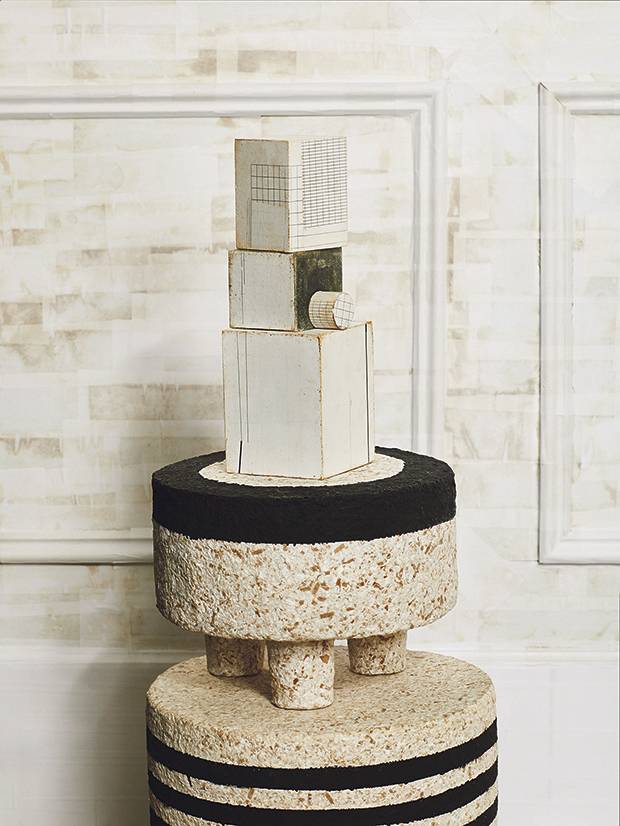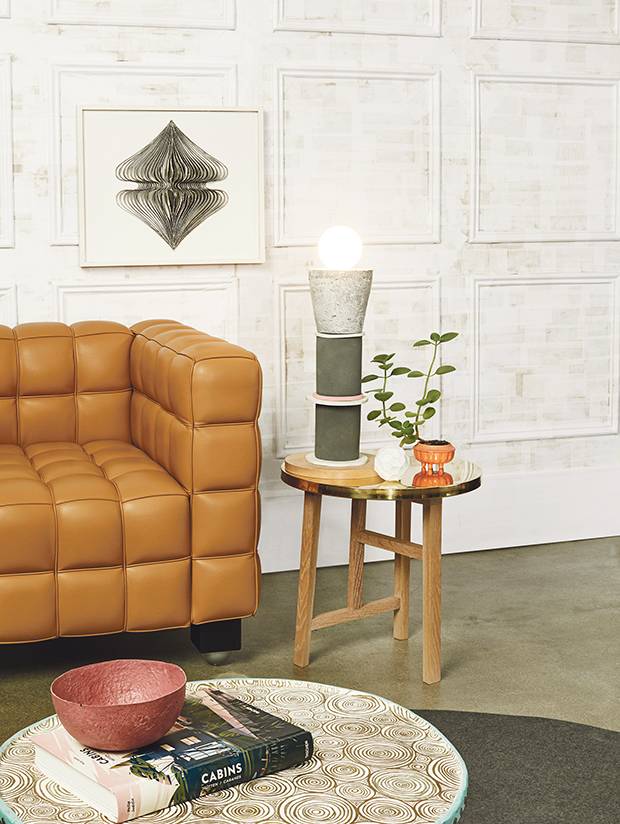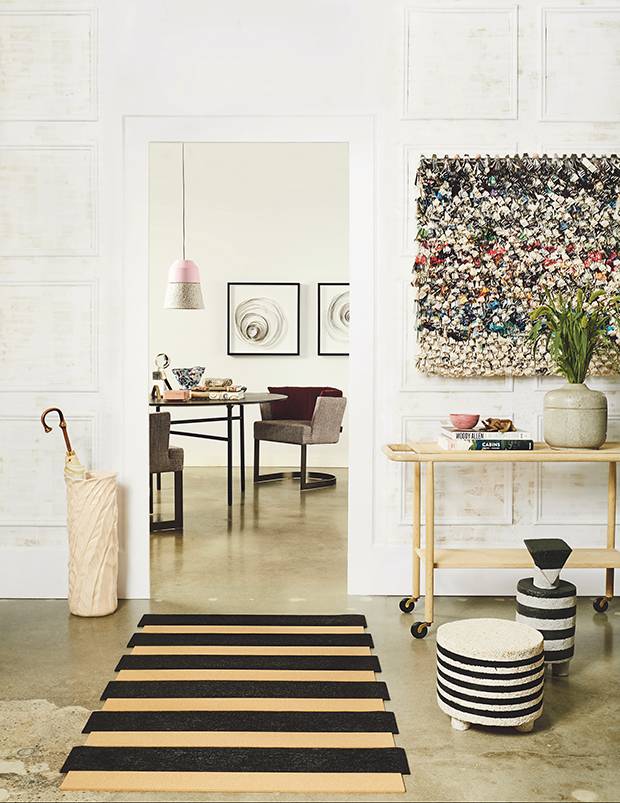Paper, in its simplest form, is flimsy and two-dimensional. When it's layered and hardened, however, the material can become anything: a bowl, a bookshelf, even a chair. Before the era of mass production, it wasn't uncommon to see a multitude of design objects rendered in papier-mâché, a craft technique of bonding shredded paper with everything from flour to glue to create volume. Now, that technique is enjoying a contemporary comeback in lighting, furniture and home accessories, and inspiring other unique processes that turn humble pulp into a major design statement.
Papier-mâché, which means "chewed paper" in French, originated in China where, shortly after paper's own invention around 100 BC, it was used to make helmets for soldiers. When the technique arrived in Europe during the 17th century, French craftsmen began using the composite to mimic plaster and stucco. Papier-mâché's ability to impersonate much sturdier materials became its primary appeal. "Often, when people are looking at it, they'll think it's concrete, then they'll pick it up and be surprised," says Noel O'Connell, co-founder of Montreal-based studio Dear Human. "It never gets old watching their expression change."
Dear Human produces an array of household pieces using the technique, from tiles to furniture. O'Connell and his partner Jasna Sokolovic used to work primarily in ceramics until they stumbled upon a much more versatile material: paper pulp. The pair sources paper from architecture firms and garment factories. The paper is first shredded and mixed with hot water. "It turns it into a mush with oatmeal-like consistency," O'Connell explains. "When we began playing around with it as a potential material, we noticed it reacted in very similar ways to ceramics. But it could do very different things that ceramics couldn't do." The material's versatility allowed the pair to work with large lightweight volumes, such as their Pulplites pendant lights and the Bibliothèque chair.

(Top to bottom) Michiko Iwata paper covered objects, price on request at Mjölk (
www.mjolk.ca). Dear Human Small Tea Table, $205, Medium Tea Table, $225 through www.dearhuman.ca.
Paper furniture enjoyed brief popularity in Victorian England when japanned papier-mâché became a major industry, producing imitations of black-lacquered Japanese housewares that were often decorated with gold leaf and mother-of-pearl inlays. In contrast, its current resurgence is more focused on sustainability than a lavish aesthetic. "The recycling part is really important for us," says Sokolovic. "We like this idea of reusing and giving a new life to the material."
Utilizing discarded materials is a driving motivation for other designers working with papier-mâché. Budapest-based studio Paper Up! produces modern sculptural lights like the elegant Dome+ pendant and tabletop objects that could also be easily mistaken for concrete or terrazzo. Founder Rita Koralevics uses only waste paper and mixes the pulp with sawdust, woodchips or other organic materials.
Atlanta-based Renée Parker, who creates decorative papier-mâché objects under the brand name Created by Renée, says she's passionate about conservation. "I like to think of the mountains of salvaged paper, cardboard and wood that have gone into my work as my contribution to the global effort," she says. The multimedia artist utilizes two forms of papier-mâché, creating paper pulp composites as well as sculpting shapes by simply gluing torn paper strips together. "Depending on the intended size and purpose of the item, I may assemble an armature in wood, wire, cardboard or clay, then build on it with paper," she says. Once the paper has dried and hardened, the armature is removed and the surface is carefully sanded and painted. "The surfaces may be a favourite part of the process for me. I get to experiment with texture and colour, and the possibilities are endless," she says. The artist's vast portfolio includes functional objects such as jewellery and pottery, as well as decorative pieces including accent balls and sculptures.

Kubus chair, $17,455 at Avenue Road (
www.avenue-road.com). Experimental Art with Paper by Moss & Lam (hanging above chair), price on request through www.mossandlam.com. Neri & Hu brass top side table, $1,670 at Mjölk. Dear Human Module Lamp, $720 through www.dearhuman.ca. Paper Ball by Kristen Lim Tung (on table), price on request through www.kronalion.com. Potted plant, stylist’s own. Artisan pink bowl, $50 (U.S.) through www.farandwidecollective.com. Renée Parker Giant Ottoman Tray, $279 (U.S.) through www.createdbyrenee.com. Interior Felt wool felt carpet, price on request through www.interiorfelt.com.
New York-based multimedia artist Poramit Thantapalit uses papier-mâché as a canvas for creative surfaces. "My concept is to combine 2-D paper art onto the 3-D objects," says Thantapalit. "I use my cyanotype and printmaking techniques to create patterns on the surface." Thantapalit employs recycled materials like cereal boxes, flyers and newspapers, shredding them and soaking them in water to create pulp, and then adding glue, flour or mineral oil. Other times, Thantapalit works directly with strips of paper and a bonding mixture made from corn starch, glue and vinegar or lemon juice. Thantapalit's objects take on irregular, organic shapes reminiscent of experimental pottery. His Retro Mosaic Bowl features a cyanotype print collage created from digital negative photography on rice paper, which is then glazed with crayon and wax via the encaustic technique of using heat to melt them onto the surface.
A resurgence of collage-style work and graphic examples of papercutting are helping to translate the paper decor trend to the art world. With a background in textiles, Toronto-based artist Robyn Thomas creates large-format hangings constructed on a loom structure with coiled book or magazine pages that are woven together. And Japanese artist Michiko Iwata uses pages from vintage notebooks to collage over wooden boxes, often drawing on the pages with pencil to create graph paper grids.

Dear Human Pulplite pendant, $450 through
www.dearhuman.ca. The Spirals by Moss & Lam (hanging on back wall), price on request through www.mossandlam.com. St. John Street dining chair, $4,760 each at Avenue Road. Snaregade black stained oak table, $2,800, Michiko Iwata paper-covered objects, price on request, paper-covered stone, $525 at Mjölk. Retro Mosaic Bowl by Poramit Thantapalit, $300 (U.S.) through www.pixibition.weebly.com. Rita Koralevics square pink bowl, €19.50 through www.behance.net/ritakoralevics. Marble bowl, $625, magnifying glass, $395 at Elte (www.elte.com).
For artists and designers sculpting with paper, creative success depends on understanding the limits and potential of the material. "Paper is something I work with on a day-to-day basis, beyond just drawing and painting," says Deborah Moss, co-founder of Moss & Lam, a custom art studio in Toronto. "I am a very curious person. What can I do to it? Rip it or tear it? What happens if you soak it in paint?"
Unwilling to dispose of leftovers from other projects, Moss began experimenting with offcuts. The result is Moss & Lam's Edge Spiral Series. To create the three-dimensional pieces, paper is torn into strips and tightened up on a coil before being left to set. "They develop a memory," Moss explains. For something so flat and ephemeral, paper's ability to transform makes it the perfect starting point – and end product – for design today.
Visit tgam.ca/newsletters to sign up for the Globe Style e-newsletter, your weekly digital guide to the players and trends influencing fashion, design and entertaining, plus shopping tips and inspiration for living well. And follow Globe Style on Instagram @globestyle.
